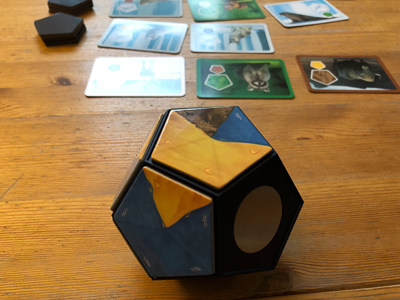

![[IMAGE]](../bilder/planet1.png) |
Author: Publisher: No. of Players: Awards: |
![[IMAGE]](../technik/box/rot/rot-3.gif) ![[IMAGE]](../technik/box/gelb/gelb-9.gif) ![[IMAGE]](../technik/box/grun/grun-6.gif) ![[IMAGE]](../technik/box/pink/pink-6.gif) ![[IMAGE]](../technik/box/blau/blau-8.gif) |
|
G@mebox author Ralf Togler writes about the game:
Since the release of Kingdomino and the beautiful tree-growing game Photosynthesis my expectations towards BLUE ORANGE GAMES are very high. So I was very excited, after I had heard that the French publisher announced a three-dimensional planet building game, simply called Planet for SPIEL 2018. Arriving at their booth, it seemed that I should not be met with disappointment. A lot of tables were crowded by people who were trying to paste colourful landscape tiles on an approximately fist-sized twelve-sided die. This not only seemed to be funny, considering all the gamers around, it also looked extremely splendid and different from all the boardgames at the other booths. Now, several weeks after the convention, I can assure you that my first impression was right: Planet is definitely one of my favourite games of 2018. Maybe it is not the gamer in me who is speaking, for Planet is certainly light-weighted with limited tactical choices. But it is always such a great presence on the table that I have no choice than to love the game.
But let us see how it works: as it happens, there is no board in Planet. The main action takes place on a big 3D planet in form of a die with 12 sides, one for every player, as it is the player's task to form a planet out of this die. At the beginning of the game, all sides of the planet are still empty, no landscapes to see, a sad sight, indeed. But this will change quickly after. Water, deserts, woods, mountains and plane are ready to be pasted on the planet in the middle of the table.
 You must know, that each side of the die is magnetic, so you can place the pentagonal, magnetic landscape tiles on the side. One can be chosen each of the 12nd rounds, so in the end the deed is done. Each landscape tile consists of one or several different landscape types, called areas in the game. And areas of the same type that are adjacent form a region (a Habit) of this landscape type, e.g. a desert, no matter if these areas are on the same landscape tile or if two landscape tiles with the same area are adjacent. The first two rounds, players only choose one of the available landscape tiles and place them on their planet. Beginning with the start player of the round, the players can choose from five randomly chosen landscape tiles for the round. You see that there is a big advantage for the starting player, because she or he still have the full selection. That's why the start player changes every round again. But players don't have to wait till the end to score in the game. From the third round on, more and more animals come into the world that wants to find a place to live. In the early rounds, there is only one new animal, but in the end game three new animals will arrive simultaneously. Which animal arrives in which round is known from start on in form of animal cards that are put face up on the table next to the planet tiles for the round.  Every animal has its own requirements, and of course it will choose the planet that best fits to these requirements. As a result, the players compare the requirements on the different planets, and the player whose landscapes meets the requirements best, takes the animal. Three different requirement types can be distinguished: having the most of one kind, having the biggest region that touches a specific Habitat and having the biggest region that isn't in contact with a specific Habitat. So, while composing your planet, you always should keep an eye on what your opponents are doing, and at the same time look ahead to what the animals are seeking. But especially he first one is to be not too easy, most players are concentrating on their own planets (me included, still after a lot of plays so far). However, the latter is a mandatory, if you want to have a chance to win, and it should be possible, because - as you will remember - all animals are visible to the players right from the beginning. As a result, players exactly know in which round which animal is coming to score.  As said at the beginning of this review, I really love the game. And it is fascinating, how BLUE ORANGE once again has created a comparable simple game with a lot of innovative material that looks awesome and is also a lot of fun. If you wanna play god, Planet seems to be a good choice. The gamer in me is satisfied with the game, but I especially recommend it as a really entertaining and different family game. | ||
|
| ||

|
|

|
|
| ||
|
Impressum / Contact Info / Disclaimer Kulkmann@aol.com
Copyright © 2018 Ralf Togler & Frank Schulte-Kulkmann, Essen, Germany | ||